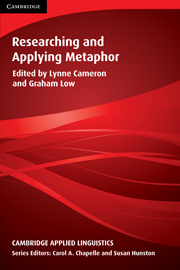Book contents
- Frontmatter
- Contents
- List of contributors
- Acknowledgements
- Conventions
- Series editors' preface
- Preface
- I KEY ISSUES IN METAPHOR RESEARCH
- 1 Operationalising ‘metaphor’ for applied linguistic research
- 2 Researching metaphor
- 3 Validating metaphor research projects
- II FROM THEORY TO DATA
- III ANALYSING METAPHOR IN NATURALLY OCCURRING DATA
- IV ANALYSING METAPHOR IN ELICITED DATA
- References
- Index
1 - Operationalising ‘metaphor’ for applied linguistic research
Published online by Cambridge University Press: 05 October 2012
- Frontmatter
- Contents
- List of contributors
- Acknowledgements
- Conventions
- Series editors' preface
- Preface
- I KEY ISSUES IN METAPHOR RESEARCH
- 1 Operationalising ‘metaphor’ for applied linguistic research
- 2 Researching metaphor
- 3 Validating metaphor research projects
- II FROM THEORY TO DATA
- III ANALYSING METAPHOR IN NATURALLY OCCURRING DATA
- IV ANALYSING METAPHOR IN ELICITED DATA
- References
- Index
Summary
The history of figurative language … [is] more of a conglomeration of discontinuities than a coherent progression toward resolution of common problems.
(Honeck, 1980: 37)A starting point: metaphor as a phenomenon of language in use
Metaphor is a device for seeing something in terms of something else.
(Burke, 1945: 503)A general type of description of metaphor often seems to be the only level at which theorists and researchers of different persuasions can agree, with similar ‘definitions’ found in many key publications (Kittay, 1987; Black, 1979; Gibbs, 1994; Lakoff & Johnson, 1980). Once past this level of generality, disagreement develops in a mire of conglomerated detail, and intending researchers may find themselves reeling as they approach the published literature in order to select an appropriate theoretical and analytic framework for a study.
In this chapter, I attempt to impose some order on this confusion by addressing various aspects of the question of how to operationalise the concept of metaphor for research of an applied linguistic nature. As applied linguists, we are concerned with language use in real-life situations, particularly problematic ones. In general terms, the applied linguistic researcher is aiming to reveal and understand underlying processes of language learning or use, and perhaps to evaluate intervention in them.
- Type
- Chapter
- Information
- Researching and Applying Metaphor , pp. 3 - 28Publisher: Cambridge University PressPrint publication year: 1999
- 71
- Cited by

